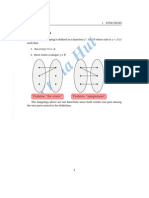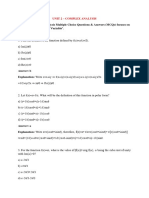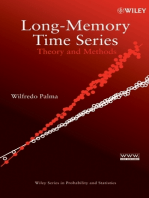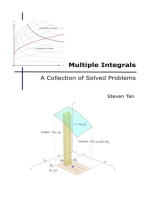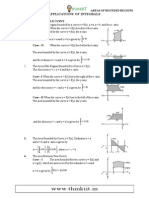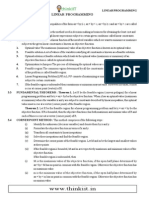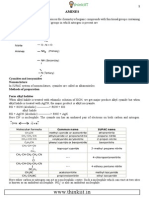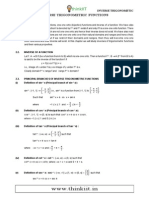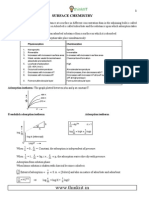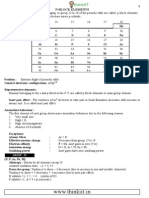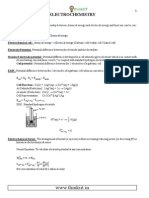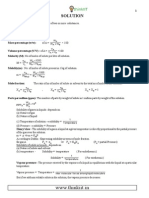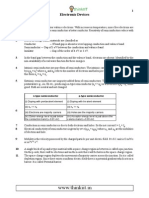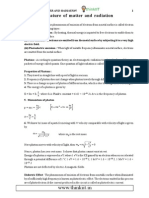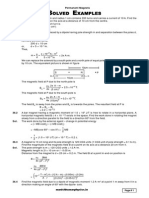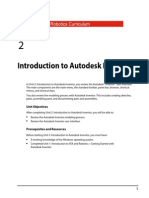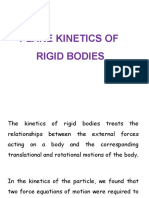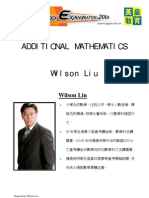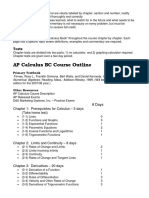Continuty and Differentibily
Continuty and Differentibily
Uploaded by
thinkiitCopyright:
Continuty and Differentibily
Continuty and Differentibily
Uploaded by
thinkiitOriginal Description:
Copyright
Share this document
Did you find this document useful?
Is this content inappropriate?
Copyright:
Continuty and Differentibily
Continuty and Differentibily
Uploaded by
thinkiitCopyright:
CONTINUTITYAND DIFFERENTIABILITY 65
www.thinkiit.in
CONTINUITY AND DIFFERENTIABILITY
3.1 BASIC CONCEPTS AND IMPORTANT RESULTS
(a) Continuity of a real function at a point
A function f is said to be left continuous or continuous from the left at x = c iff
(i) f(c) exists (ii)
c x
Lt
f(x) exists and (iii)
c x
Lt
f(x) =
f(c).
A function f is said to be right continuous or continuous from the right at x = c iff
(i) f(c) exists (ii) +
c x
Lt
f(x) exists and (iii) +
c x
Lt
f(x) =
f(c).
A function f is said to be continuous at x = c iff
(i) f(c) exists (ii)
c x
Lt
f(x) exists and (iii)
c x
Lt
f(x) =
f(c).
Hence, a function is continuous at x = c iff it is both left as well as right continuous at x = c.
When
c x
Lt
f(x) exists but either f(c) does not exist or
c x
Lt
f(x) = f(c), we say that f
has a removable discontinuity; otherwise, we say that f has non-removable discontinuity.
(b) Continuity of a function in an interval
A function f is said to be continuous in an open interval (a, b) iff f is continuous at every
point of the interval (a, b) ; and f is said to be continuous in the closed interval [a, b] iff f is
continuous in the open interval (a, b) and it is continuous at a from the right and at b from
the left.
Continuous function. A function is said to be a continuous function iff it is continuous at
every point of its domain. In particular, if the domain is a closed interval, say [a, b], then f
must be continuous in (a, b) and right continuous at a and left continuous at b.
The set of all point where the function is continuous is called its domain of continuity. The
domain of continuity of a function may be a proper subset of the domain of the function.
3.2 PROPERTIES OF CONTINUOUS FUNCTIONS
Property 1. Let f, g be two functions continuous at x = c, then
(i) of is continuous at x = c, o e R (ii) f + g is continuous at x = c
(iii) f g is continuous at x = c (iv) fg is continuous at x = c
(v)
g
f
is continuous at x = c, provided g(c) = 0.
Property 2. Let D
1
and D
2
be the domains of continuity of the functions f and g respectively
then
(i) of is continuous on D
1
for all o e R (ii) f + g is continuous on D
1
D
2
(iii) f g is continuous on D
1
D
2
(iv) fg is continuous on D
1
D
2
(v)
g
f
is continuous on D
1
D
2
except those points where g(x) = 0.
Property 3. A polynomial function is continuous everywhere.
In particular, every constant function and every identity function is continuous.
Property 4. A rational function is continuous at every point of its domain.
Property 5. If f is continuous at c, then | f | is also continuous at x = c.
In particular, the function | x | is continuous for every x e R.
Property 6. Let f be a continuous one-one function defined on [a, b] with range [c, d], then
the inverse function f
1
: [c, d] [a, b] is continuous on [c, d]
Property 7. If f is continuous at c and g is continuous at f(c), then gof is continuous at c.
Property 8. All the basic trigonometric functions i.e. sin x, cos x, tan x, cot x, sec x and
cosec x are continuous.
Property 9. All basic inverse trigonometric functions i.e. sin
1
x, cos
1
x, tan
1
x, cot
1
x, sec
1
x, cosec
1
x are continuous (in their respective domains).
Property 10. Theorem. If a function is differentiable at any point, it is necessarily continuous
at that point.
The converse of the above theorem may not be true i.e. a function may be continuous at a
point but may not be derivable at that point.
3.3 DERIVATIVE OF VARIOUS FUNCTIONS
(a) Derivative of composite functions
CONTINUTITYAND DIFFERENTIABILITY 67
www.thinkiit.in
(ii)
dx
d
(a
x
) = a
x
log a, a > 0, a = 1, x e R (v)
dx
d
(log | x |) =
x
1
, x = 0
(iii)
dx
d
(log x) =
x
1
, x > 0 (iv)
dx
d
(log
a
x) =
a log x
1
, x > 0, a > 0, a = 1
(e) Logarithmic differentiation
If u, v are differentiable functions of x, then
dx
d
(u
v
) = u
v
dx
d
(v log u).
(f) Derivatives of functions in parametric form
If x and y are two variables such that both are explicitly expressed in terms of a third
variable, say t, i.e. if x = f(t) and y = g(t), then such functions are called parametric
functions and
dx
dy
=
dt
dx
dt
dy
, provided
dt
dx
= 0.
(g) Derivative of second order
If a function f is differentiable at a point x, then its derivative f is called the first derivative or
derivative of first order of the function f. If f is further differentiable at the same point x,
then its derivative is called the second derivative or derivative of the second order of f at
that point and is denoted by f.
If the function f is defined by y = f(x), then its first and second derivatives are denoted by f
(x) and f(x) or by
dx
dy
and
2
2
dx
y d
or by y
1
and y
2
or by y and y respectively..
3.4 ROLLES THEOREM AND LAGRANGES MEAN VALUE THEOREM
(i) Rolles theorem
If a function f is
(i) continuous in the closed interval [a, b]
(ii) derivable in the open interval (a, b) and
(iii) f(a) = f(b),
then there exists atleast one real number c in (a, b) such that f(c) = 0.
Thus converse of Rolles theorem may not be true.
(ii) Lagranges mean value theorem
If a function f is
(i) continuous in the closed interval [a, b] and
(ii) derivable in the open interval (a, b),
then there exists atleast one real number c in (a, b) such that f (c) =
a b
) a ( f ) b ( f
The converse of Lagranges mean value theorem may not be true.
CONTINUTITYAND DIFFERENTIABILITY 69
www.thinkiit.in
Hence, +
0 x
lim
f(x) =
0 x
lim
f(x) = f(0)
So, f is continuous at x = 0
This implies that f is a continuous func-
tion at all x e R.
Ex.5 Examine the continuity of f, where f is
defined by
f ( x) =
=
0 x if , 1
0 x if , x cos x sin
Sol. Here, f(0) = 1
Also, +
0 x
lim
f(x)=
0 h
lim
f(0+h)=
0 h
lim
[sin(0+h)
cos(0+h)]
=
0 h
lim
[sin h cos h] =
1
and
0 x
lim
f(x)=
0 h
lim
f(0h)=
0 h
lim
[sin(0h)
cos(0h)]
=
0 h
lim
[sin h cos h]
[ sin (h) = sin h]
= 0 1 = 1
and cos (h) = cos
h]
Hence, +
0 x
lim
f(x) =
0 x
lim
f(x) = f(0)
So, f is continuous at x = 0; and hence
continuous at all x e R.
Ex.6 Find the value of k so that the follow-
ing function f is continuous at the indi-
cated point :
(i) f( x) =
>
+
5 x if , 5 x 3
5 x if , 1 kx
at x = 5
(ii) f( x) =
>
2 x if , 3
2 x if , kx
2
at x = 2
Sol. (i) Since f is given to be continuous
at x = 5, we have
+
5 x
lim
f(x) =
5 x
lim
f(x) = f(5)
0 h
lim
f(5 + h) =
0 h
lim
f(5 h) = f(5)
0 h
lim
[3(5+h)5]=
0 h
lim
[k(5h)+1] =
5k + 1
10 = 5k + 1 k =
5
9
(ii) Since f is given to be continuous
at x = 2, we have
+
2 x
lim
f(x) =
2 x
lim
f(x) = f(2)
0 h
lim
f(2 + h) =
0 h
lim
f(2 h) = f(2)
0 h
lim
(3) =
0 h
lim
[k(2 h)
2
] = 4k
3 = 4k k =
4
3
Ex.7 Find the val ues of a and b such that
the function defined by
f( x) =
< +
10 x if , 21
10 x 2 if , b ax
2 x if , 5
is a continuous function.
Sol. Since the function f is continuous, it is
continuous at x = 2 as well as at x = 10.
So, +
2 x
lim
f(x) =
2 x
lim
f(x) = f(2)
i.e.,
0 h
lim
f(2 + h) =
0 h
lim
f(2 h)
= f(2)
i.e., 2a + b = 5 (......1)
and +
10 x
lim
f(x) =
10 x
lim
f(x) = f(10)
i.e.,
0 h
lim
f(10 + h) =
0 h
lim
f(10 h) = f(10)
i.e., 21 = 10a + b (......2)
From (1) and (2), we find that
a = 2 and b = 1
Ex.8 Show t hat t he f unct i on def i ned by
g( x) = x [ x] i s di scont i nuous at
al l i ntegral points. Here, [ x] denotes
the greatest integer less than or equal
to x.
Sol. The function f(x) = x [x] can be written
as
f(x) =
+ < <
< <
1 k x k if , k x
k x 1 k if ), 1 k ( x
, where k is
an arbitrary integer.
Now, +
k x
lim
f(x)=
0 h
lim
f(k + h)=
0 h
lim
[(k+h)
k]=0
and
k x
lim
f(x)=
0 h
lim
f(kh)=
0 h
lim
[(kh) (k
1)]=1
Since, +
k x
lim
f(x) =
k x
lim
f(x), the function
f is not continuous at x = k.
Since k is an arbitrary integer, we can eas-
ily conclude that the function is discon-
tinuous at all integral points.
CONTINUTITYAND DIFFERENTIABILITY 71
www.thinkiit.in
c = a or c = b or c =
n m
na mb
+
+
Since c =
n m
na mb
+
+
e (a, b), the Rolles
Theorem is verified.
Ex.12 Show t hat t he f unct i on f ( x) =
>
+
2 x if , x 5
2 x if , x 1
is continuous at x = 2, but
not differentiable at x = 2.
Sol. At x = 2,
+
2 x
lim
f(x) =
0 h
lim
f(2 + h) =
0 h
lim
[5(2+
h)] = 3
2 x
lim
f(x) =
0 h
lim
f(2 h) =
0 h
lim
[1+(2h)]
= 3
Also, f(2) = 1 + 2 = 3
Since, +
2 x
lim
f(x) =
2 x
lim
f(x) = f(2), f(x)
is continuous at x = 2.
Next, Lf (2) =
0 h
lim
h
) 2 ( f ) h 2 ( f
=
0 h
lim
=
h
) 2 1 ( ) h 2 1 (
+ +
= 1
Rf (2)=
0 h
lim
h
) 2 ( f ) h 2 ( f +
=
0 h
lim
=
h
) 2 1 ( ) h 2 ( 5 + +
= 1
Since, Lf (2) = Rf (2), the function f is
not differentiable at x = 2.
Ex.13 Show t hat t he f unct i on f ( x) =
<
1 x if , 1 x
1 x if , x 1
2 is continuous at x = 1, but
not differentiable thereat.
Sol. The function is continuous at x = 1, be-
cause
+
1 x
lim
f(x) =
1 x
lim
f(x) = f(1) as shown be-
low :
+
1 x
lim
f(x) =
0 h
lim
f(1 + h) =
0 h
lim
[(1 + h)
2
1] =
0 h
lim
(h
2
+ 2h) = 0 ;
1 x
lim
f(x) =
0 h
lim
f(1 h) =
0 h
lim
[1 (1
h)] =
0 h
lim
(h) = 0
and f(1) = (1)
2
1 = 1 1 = 0
Further, Rf (1) =
0 h
lim
h
) 1 ( f ) h 1 ( f +
=
0 h
lim
2
[ (1 h) 1] [ 0]
h
+
= 2
Lf (1) =
0 h
lim
f(1 h) f(1)
h
=
0 h
lim
2
[ (1 h) 1] [ 0]
h
=
0 h
lim
\
|
h
h
=
0 h
lim
(1) = 1
Since, Rf (1) = Lf (1), the function is
not differentiable at x = 1.
Ex.14 Show that the function f defined as
f( x) =
>
<
<
2 x if , 4 x 5
1 x 1 if , x x 2
1 x 0 if , 2 x 3
2
is continuous at x = 2, but not differ-
entiable thereat.
Sol. At x=2, +
2 x
lim
f(x)=
0 h
lim
f(2+h)=
0 h
lim
[5(2+h)
4]=6
2 x
lim
f(x) =
0 h
lim
f(2h)=
0 h
lim
[2(2h)
2
(2h)]
=
0 h
lim
[2(4 4h + h
2
) (2 h)]
=
0 h
lim
[6 7h + 2h
2
] = 6
and f(2) = 2 (2)
2
2 = 8 2 = 6
Since +
2 x
lim
f(x) =
2 x
lim
f(x)=f(2), the
function f is continuous at x = 2.
Next, Lf (2) =
0 h
lim
h
) 2 ( f ) h 2 ( f
=
0 h
lim
h
] 4 ) 2 ( 5 [ ) h 2 ( ) h 2 ( 2
2
=
h
6 h 2 h 7 6
2
+
= 7
f (2) =
0 h
lim
h
) 2 ( f ) h 2 ( f +
=
0 h
lim
h
] 4 ) 2 ( 5 [ ] 4 ) h 2 ( 5 [ +
=
0 h
lim
h
] 4 ) 2 ( 5 [ ] 4 ) h 2 ( 5 [ +
=
0 h
lim
1
]
1
+
h
6 h 5 6
= 5
Since, Lf (2) = Rf (2), the func-
tion f is not differentiable at x = 2.
CONTINUTITYAND DIFFERENTIABILITY 73
www.thinkiit.in
Q.12 (i) If y =
x 1
x 1
+
, prove that (1 x
2
)
dx
dy
+ y = 0
(ii) If y =
|
|
\
|
+
+ +
1 x 1 x
1 x 1 x
, prove that
dx
dy
=
1 x
1 x x
2
2
+
(iii) If y =
x sin x cos
x sin x cos
+
, show that
dx
dy
= sec
2
|
\
| t
+
4
x
(iv) If y =
x tan x sec
x tan x sec
+
, show that
dx
dy
= sec x (sec x + tan x)
Q.13 (i) If y =
x
+
x
1
, show that 2x
dx
dy
+ y = 2 x (ii) If y = x sin y, prove that x
dx
dy
=
) y cos x 1 (
y
(iii) If x y 1+ + y
x 1+
= 0, prove that
dx
dy
=
2
) x 1 (
1
+
, x = y
Q.14 If y = , ........ x x x + + + prove that
dx
dy
=
) 1 y 2 (
1
Q.15 Given that cos
2
x
. cos
4
x
. cos
8
x
......=
x
x sin
, prove that
2
2
1
sec
2
2
x
+
4
2
1
sec
2
4
x
+ ......=
cosec
2
x
2
x
1
Q.16 If x = tan
1
2
t 1
t 2
and y = sin
1
2
t 1
t 2
+
, show that
dx
dy
= 1.
Q.17 Differentiate : (i) sin
1
)
`
+
2
x 1 x x 1 x (ii) tan
1
|
|
\
|
+
2
x 15 1
x 2
(iii) tan
1
|
|
\
|
+ + 1 x x
1
2
+ tan
1
|
|
\
|
+ + 3 x 3 x
1
2
+ tan
1
|
|
\
|
+ + 7 x 5 x
1
2
+ ............ to n terms.
Q.18 Differentiate : (i) tan
1
|
|
\
|
2
x 1
x
+ tan
1
|
|
\
|
+
2
x 1 1
x
(ii) cos
1
|
\
|
5
x sin 4 x cos 3
Q.19 Differentiate : sin
1
|
|
\
|
+
2
x 1
1
+ tan
1
|
|
|
\
|
+
x
1 x 1
2
.
Q.20 Differentiate : (i) sin
1
|
|
\
|
+ +
2
x 1 x 1
(ii) cos
1
|
|
\
|
+
1
1
x x
x x
Q.21 Discuss the continuity of the function f(x) =
> +
<
0 x if , 1 x 2
0 x if , 1 x 2
Q.22 If a function f(x) is defined as f(x) =
=
=
4 x , 0
4 x ,
4 x
| 4 x |
show that f is everywhere continuous except
at x = 4.
Q.23 Discuss the continuity of the function f(x) = | x | + |x 1| in the interval [1, 2]
Q.24 Show that f(x) = | x | is not differential at x = 1.
Q.25 Let f(x) =
<
> +
0 x if , x 2
0 x if , x 2
, show that f(x) is not derivable at x = 0.
Q.26 Show that the function f(x) =
=
= |
\
|
0 x if , 0
0 x if ,
x
1
sin x
2
is differential at x = 0 and f (0) = 0.
CONTINUTITYAND DIFFERENTIABILITY 75
www.thinkiit.in
Q.16 Prove that
dx
d
|
|
\
|
+
2
x
sin
2
a
x a
2
x
1
2
2 2
=
2 2
x a . [C.B.S.E. 2004]
Q.17 If y = (sin x)
x
+ (cos x)
tan x
, find
dx
dy
[C.B.S.E. 2004]
Q.18 Find
dx
dy
, when x = a
2
2
t 1
t 1
+
, y =
2
t 1
bt 2
+
[C.B.S.E. 2004]
Q.19 Differentiate tan
1
|
|
\
|
2
x 1
x 2
w.r.t. sin
1
|
|
\
|
+
2
x 1
x 2
. [C.B.S.E. 2004]
Q.20 If f(x) =
x 3 2
x 1
x 3
+
|
\
|
+
+
, find f (0). [C.B.S.E. 2005]
Q.21 Find
dx
dy
if : x = a
|
|
\
|
+
2
2
t 1
t 1
, y =
2
t 1
t 2
[C.B.S.E. 2005]
Q.22 If y = x log
|
\
|
+ bx a
x
, prove that
2
2
dx
y d
=
x
1
2
bx a
a
|
\
|
+
.
[C.B.S.E. 2005]
Q.23 If the function f defined by f(x) =
>
+
=
<
0 x ,
4 x 16
x
0 x , a
0 x ,
x
x 4 cos 1
2
is continuous at x = 0, find the value
of a.
[C.B.S.E. 2006]
Q.24 If y = x +
x
1
, then show that 2x
dx
dy
+ y = 2 x .
[C.B.S.E. 2006]
Q.25 Differentiate w.r.t. x : tan
1
|
|
\
|
+
+ +
x sin 1 x sin 1
x sin 1 x sin 1
[C.B.S.E. 2006]
Q.26 If y 1 x
2
+ = log ( 1 x
2
+ x), prove that (x
2
+ 1)
dx
dy
+ xy + 1 = 0.
[C.B.S.E. 2006]
Q.27 If x = a sin 2t (1 + cos 2t) and y = b cos 2t (1 cos 2t), show that
a
b
dx
dy
4
t
= |
\
|
t
=
.
[C.B.S.E. 2006]
Q.28 If y = cosec x + cot x, show that sin x .
2
2
dx
y d
= y
2
. [C.B.S.E. 2006]
Q.29 Verify LMV ; find c f(x) = x
2
+ 2x + 3 in [4, 6] [C.B.S.E. 2006]
Q.30 If f(x) =
=
=
5 x , k
5 x ,
5 x
25 x
2
is continuous at x = 5, find the value of k. [C.B.S.E. 2007]
Q.31 If y = 3e
2x
+ 2e
3x
, prove that
2
2
dx
y d
5
dx
dy
+ 6y = 0. [C.B.S.E. 2007]
CONTINUTITYAND DIFFERENTIABILITY 77
www.thinkiit.in
Q.46 Differentiate the following function w.r.t. x : x
sin x
+ (sin x)
cos x
[C.B.S.E. 2009]
Q.47 x
sin x
|
\
|
+ x log x cos
x
x sin
+ (sin x)
cos x
(cos x cot x sin x logsin x)
Q.48 Find
dx
dy
if (x
2
+ y
2
)
2
= xy.. [C.B.S.E. 2009]
Q.49 If y = 3 cos (log x) + 4 sin (log x), then show that x
2
.
2
2
dx
y d
+ x
dx
dy
+ y = 0
[C.B.S.E. 2009]
Q.50 If y = cos
1
|
|
|
\
|
+
5
x 1 4 x 3
2
, find
dx
dy
. [C.B.S.E. 2010]
Q.51 If y = cosec
1
x, x > 1, then show that x (x
2
1)
2
2
dx
y d
+ (2x
2
1)
dx
dy
= 0
[C.B.S.E. 2010]
Q.52 If x
y
= e
x y
, show that
dx
dy
=
2
)} xe ( {log
x log
. [C.B.S.E. 2011]
Q.53 If x = tan |
\
|
y log
a
1
, show that (1 + x
2
)
2
2
dx
y d
+ (2x a)
dx
dy
= 0 [C.B.S.E. 2011]
Q.54 If x =
t sin
1
a
, y =
t cos
1
a
, show that
x
y
dx
dy
= .
[C.B.S.E. 2012]
Q.55 Differentiate tan
1
1
1
]
1
+
x
1 x 1
2
with respect to x.
[C.B.S.E. 2012]
Q.56 If x = a (cos t + t sin t) and y = a (sin t t cos t), 0 < t <
2
t
, find
2
2
2
2
dt
y d
,
dt
x d
and
2
2
dx
y d
.[C.B.S.E. 2012]
Q.57 If y
x
= e
y x
, prove that
y log
log) 1 (
dx
dy
2
+
=
. [C.B.S.E. 2013]
Q.58 Differentiate the following with respect to x :
[C.B.S.E. 2013]
sin
1
|
|
\
|
+
+
x
x 1 x
) 36 ( 1
3 . 2
Q.59 Find the value of k, for which
[C.B.S.E. 2013]
f(x) =
< s
+
< s
+
1 x 0 if ,
1 x
1 x 2
0 x 1 if ,
x
kx 1 kx 1
is continuous at x = 0.
OR
If x = a cos
3
u and y = a sin
3
u, then find the value of
2
2
dx
y d
at u =
6
t
.
You might also like
- Neper Reference ManualDocument80 pagesNeper Reference Manualalicarlos13No ratings yet
- 7 - Continuity and Differentiability PDFDocument16 pages7 - Continuity and Differentiability PDFthinkiitNo ratings yet
- NCERT Continuity & DifferentiationDocument31 pagesNCERT Continuity & Differentiationmastermohit1No ratings yet
- Limit Contion DifferDocument25 pagesLimit Contion DifferSayan Kumar KhanNo ratings yet
- School of Mathematics and Physics, The University of QueenslandDocument1 pageSchool of Mathematics and Physics, The University of QueenslandVincent LiuNo ratings yet
- Real Analysis LectureDocument21 pagesReal Analysis Lectureruchi21july25% (4)
- 09 01 Differentiation PDFDocument24 pages09 01 Differentiation PDFSri DNo ratings yet
- Continuous FunctionDocument9 pagesContinuous FunctionNur AmaninaNo ratings yet
- Final Notes For AB and BCDocument16 pagesFinal Notes For AB and BCsapabapjava2012No ratings yet
- Application of Derivatives: Rate of Change of QuantityDocument8 pagesApplication of Derivatives: Rate of Change of QuantityRudra Kapil VishwakarmaNo ratings yet
- Calculus Review and Formulas: 1 FunctionsDocument11 pagesCalculus Review and Formulas: 1 FunctionsRaymond BalladNo ratings yet
- Prima Hut: 1 FunctionsDocument30 pagesPrima Hut: 1 FunctionsRaju SharmaNo ratings yet
- Function Equation BasicDocument9 pagesFunction Equation Basicmonkeydbomlol123No ratings yet
- C01 Calculus of One Variable - T1 - 1112Document51 pagesC01 Calculus of One Variable - T1 - 1112Zachary NgNo ratings yet
- SequnceSeries of FunctionsDocument50 pagesSequnceSeries of FunctionsAlecsandra RusuNo ratings yet
- 07-Limit ContDocument15 pages07-Limit ContAnonymous BnbPSoovbNNo ratings yet
- Class XII Mathematics Continuity and Differentiability Chapter Notes Key DefinitionsDocument5 pagesClass XII Mathematics Continuity and Differentiability Chapter Notes Key DefinitionsAbhi XavierNo ratings yet
- Appli CsDocument5 pagesAppli CshazrolNo ratings yet
- Continuity 413Document69 pagesContinuity 413ChuyiyaNo ratings yet
- 28 Continuity & Diffrentiability Part 1 of 1Document23 pages28 Continuity & Diffrentiability Part 1 of 1Mehul JainNo ratings yet
- IB 11derivatives (52 59)Document3 pagesIB 11derivatives (52 59)sam_punxtar16No ratings yet
- Basic Calculus L2Document14 pagesBasic Calculus L2Abbie MalutoNo ratings yet
- Check Continuity of Functions and Determine DiscontinuitiesDocument3 pagesCheck Continuity of Functions and Determine Discontinuitiesksr131No ratings yet
- Chapter 5: Continuous FunctionsDocument18 pagesChapter 5: Continuous FunctionsdiyahNo ratings yet
- Lec 9 Continuity PDFDocument41 pagesLec 9 Continuity PDFAbrar Ul HaqNo ratings yet
- Lecture 2:Continuity 函数的连续性Document10 pagesLecture 2:Continuity 函数的连续性zhangliang623No ratings yet
- Functional Equations: 1. Basic Techniques in Solving Functional Equations in One VariableDocument9 pagesFunctional Equations: 1. Basic Techniques in Solving Functional Equations in One VariableEduardoNo ratings yet
- CalculusDocument15 pagesCalculusrpdemaladeNo ratings yet
- General MathDocument7 pagesGeneral Mathboughanmimolka25No ratings yet
- Sheet - 01 - Differentiability NJ - 247Document17 pagesSheet - 01 - Differentiability NJ - 2471qerfdNo ratings yet
- Preparatory Questions: 1. Verify That The Function FDocument6 pagesPreparatory Questions: 1. Verify That The Function FTOM DAVISNo ratings yet
- 19 FunctionsDocument10 pages19 Functionssri2472018No ratings yet
- Functions: If F (X) 2x - 2x + 1, Find F ( - 1) - (B) If F (T) 3t - 1, Find F (A)Document14 pagesFunctions: If F (X) 2x - 2x + 1, Find F ( - 1) - (B) If F (T) 3t - 1, Find F (A)Dinesh RajNo ratings yet
- P1T2 FunctionsDocument37 pagesP1T2 FunctionsmarzuqsadiqNo ratings yet
- TheoremsDocument6 pagesTheoremsMickey BoyNo ratings yet
- 9426 - Some Suggestions For Review For Test2-PMT0101 (T3-1415)Document10 pages9426 - Some Suggestions For Review For Test2-PMT0101 (T3-1415)YoongHong ChoyNo ratings yet
- Unit 5Document5 pagesUnit 5josephkapumburu0No ratings yet
- Continuity Exe SheetDocument31 pagesContinuity Exe SheetSarthak MishraNo ratings yet
- Economics 204 Fall 2012 Problem Set 5 Suggested SolutionsDocument8 pagesEconomics 204 Fall 2012 Problem Set 5 Suggested SolutionsFunWithNumbers88No ratings yet
- Ma1505 CheatDocument4 pagesMa1505 CheatSouseiseki ChromeNo ratings yet
- Sheet - 01 - ContinuityDocument16 pagesSheet - 01 - ContinuityNoob Game PlayNo ratings yet
- Unit 2 - Complex AnalysisDocument32 pagesUnit 2 - Complex AnalysisPavan BagalNo ratings yet
- Lect2 06webDocument14 pagesLect2 06webKashif KashifNo ratings yet
- MATH-1211-01_Written_Assignment_Unit_1Document7 pagesMATH-1211-01_Written_Assignment_Unit_1Nel MatrixNo ratings yet
- Fundamentals of Analysis: WwlchenDocument16 pagesFundamentals of Analysis: WwlchenGanesh KumarNo ratings yet
- 08 04 ContinuityDocument10 pages08 04 Continuitydev.ankit.joshiNo ratings yet
- Continuity and DifferentiabilityDocument31 pagesContinuity and DifferentiabilityKavyaNo ratings yet
- NotesDocument20 pagesNotesUPAHAR SWAPNASHISNo ratings yet
- Continuity at A PointDocument25 pagesContinuity at A PointKatrina Mae CruzNo ratings yet
- Mathematics For EngineeringDocument58 pagesMathematics For EngineeringĐức NguyênNo ratings yet
- MAT060 - 8 - Continuity of A Function Bent UsmanDocument41 pagesMAT060 - 8 - Continuity of A Function Bent Usmanamer.pp951No ratings yet
- Lecture2 ExtremaDocument27 pagesLecture2 Extremaarpitshirbhate25No ratings yet
- MTPDF3 The Derivatives Basic Differentiation Rules and The Chain Rule PDFDocument38 pagesMTPDF3 The Derivatives Basic Differentiation Rules and The Chain Rule PDFLuis FonbuenaNo ratings yet
- Test2 en MaterialDocument16 pagesTest2 en MaterialAlejandro Ca MaNo ratings yet
- Applications of DerivativesDocument25 pagesApplications of DerivativesswadhinNo ratings yet
- Differentiation (Calculus) Mathematics Question BankFrom EverandDifferentiation (Calculus) Mathematics Question BankRating: 4 out of 5 stars4/5 (1)
- Hyperbolic Functions (Trigonometry) Mathematics E-Book For Public ExamsFrom EverandHyperbolic Functions (Trigonometry) Mathematics E-Book For Public ExamsNo ratings yet
- Inverse Trigonometric Functions (Trigonometry) Mathematics Question BankFrom EverandInverse Trigonometric Functions (Trigonometry) Mathematics Question BankNo ratings yet
- 13 - Three-Dimensional Geometry PDFDocument20 pages13 - Three-Dimensional Geometry PDFthinkiitNo ratings yet
- 12 Vectors PDFDocument14 pages12 Vectors PDFthinkiitNo ratings yet
- 15 Probability PDFDocument16 pages15 Probability PDFthinkiit100% (2)
- 10 - Areas of Bounded Regions PDFDocument8 pages10 - Areas of Bounded Regions PDFthinkiitNo ratings yet
- 9 Integrals PDFDocument19 pages9 Integrals PDFthinkiitNo ratings yet
- 14 - Linear Programming PDFDocument13 pages14 - Linear Programming PDFthinkiitNo ratings yet
- 11 - Differential Equations PDFDocument9 pages11 - Differential Equations PDFthinkiitNo ratings yet
- 15 - Amines (New) PDFDocument25 pages15 - Amines (New) PDFthinkiitNo ratings yet
- 5 Matrices PDFDocument14 pages5 Matrices PDFthinkiit0% (1)
- 2 - Inverse Trigonometic FunctionsDocument19 pages2 - Inverse Trigonometic FunctionsHarsh RaviNo ratings yet
- 8 - Applications of Derivatives PDFDocument15 pages8 - Applications of Derivatives PDFthinkiitNo ratings yet
- Surface ChemistryDocument12 pagesSurface ChemistryMecho HillNo ratings yet
- 10 - D - and F - Block Elements PDFDocument18 pages10 - D - and F - Block Elements PDFthinkiit100% (19)
- 18 - Chemistry in Everyday Life (New) PDFDocument17 pages18 - Chemistry in Everyday Life (New) PDFthinkiit60% (10)
- 9 - P-Block Elements PDFDocument27 pages9 - P-Block Elements PDFthinkiit86% (7)
- 5 - Electrochemistry PDFDocument15 pages5 - Electrochemistry PDFthinkiit100% (1)
- 8 - Atoms and Nuclei PDFDocument25 pages8 - Atoms and Nuclei PDFthinkiit67% (3)
- 6 - Chemical Kinetics PDFDocument16 pages6 - Chemical Kinetics PDFthinkiit100% (1)
- 4 Solution PDFDocument14 pages4 Solution PDFthinkiitNo ratings yet
- 6 Optics PDFDocument29 pages6 Optics PDFthinkiitNo ratings yet
- 3 - Solid State PDFDocument15 pages3 - Solid State PDFthinkiitNo ratings yet
- 4 - Electromagnetic Induction & AC PDFDocument15 pages4 - Electromagnetic Induction & AC PDFthinkiitNo ratings yet
- Magnetic Field Due To CurrentDocument21 pagesMagnetic Field Due To Currentthinkiit100% (2)
- 9 - Electronic Devices PDFDocument28 pages9 - Electronic Devices PDFthinkiitNo ratings yet
- Magnetic Properties of MatterDocument5 pagesMagnetic Properties of Matterthinkiit100% (1)
- 7 - Dual Nature of Matter and Radiation PDFDocument16 pages7 - Dual Nature of Matter and Radiation PDFthinkiit88% (8)
- 5 - Electromagnetic Waves PDFDocument8 pages5 - Electromagnetic Waves PDFthinkiit100% (1)
- Permanent MagnetDocument15 pagesPermanent MagnetthinkiitNo ratings yet
- 2 - Current Electricity PDFDocument27 pages2 - Current Electricity PDFthinkiitNo ratings yet
- 2112.05724v1Document17 pages2112.05724v1Devang BajpaiNo ratings yet
- CH 04Document17 pagesCH 04Raf.Z100% (2)
- FW1 Simple Horizontal CurveDocument5 pagesFW1 Simple Horizontal CurveAthena ClubNo ratings yet
- Introduction To Autodesk Inventor: Unit ObjectivesDocument44 pagesIntroduction To Autodesk Inventor: Unit ObjectivesRoxana Cristina PopescuNo ratings yet
- 3rd Quarter Exam Geometry 2012Document5 pages3rd Quarter Exam Geometry 2012Alfredo L. CariasoNo ratings yet
- Seminar QNS 2023Document16 pagesSeminar QNS 2023EMMANUEL BIRUNGINo ratings yet
- IOQM 2023 Solution 03092023Document22 pagesIOQM 2023 Solution 03092023AKANKSHA DIXIT100% (1)
- CHP # 3 Equilibrium of A ParticleDocument18 pagesCHP # 3 Equilibrium of A Particlewasiqirshad947No ratings yet
- مخططات العمل لمعايير المناهج بدولة قطر لمادة الرياضياتDocument173 pagesمخططات العمل لمعايير المناهج بدولة قطر لمادة الرياضياتKhalid MeqdadNo ratings yet
- Kinetics of Rigid BodyDocument32 pagesKinetics of Rigid BodyMuhammad FirdawsNo ratings yet
- Pre Calculus TQ 1st Q Examination With Answer KeyDocument4 pagesPre Calculus TQ 1st Q Examination With Answer KeySamuel Jr CatulposNo ratings yet
- SpaceDocument2 pagesSpaceDarkwah Hilda AsareNo ratings yet
- History of Mathematical NotationDocument4 pagesHistory of Mathematical NotationKeena Joy Awisan - PinasNo ratings yet
- Grade 11 Mathematics 3rd Term Test Paper 2018 English Medium - North Western ProvinceDocument19 pagesGrade 11 Mathematics 3rd Term Test Paper 2018 English Medium - North Western Provinceudeshrandikaudayanga0% (1)
- Curves and Curve FittingDocument37 pagesCurves and Curve FittingTika PsbNo ratings yet
- Output of Suspension AnalysesDocument44 pagesOutput of Suspension AnalysesLFoster1No ratings yet
- MI1026 Calculus IIDocument3 pagesMI1026 Calculus IIDương Cá ThuNo ratings yet
- Inverse Trigonometric FunctionsDocument12 pagesInverse Trigonometric FunctionsHéctorValleNo ratings yet
- GIMO SyllabusDocument6 pagesGIMO Syllabusseshadri n jNo ratings yet
- Good Hope School 13-18-3B Ch.7 Areas and Volumes III CQDocument9 pagesGood Hope School 13-18-3B Ch.7 Areas and Volumes III CQtonghoyeungNo ratings yet
- 2009 HSC Exam MathematicsDocument16 pages2009 HSC Exam MathematicsYoga NathanNo ratings yet
- Csec Additional Mathematics May 2021 PDFDocument132 pagesCsec Additional Mathematics May 2021 PDFJoshua SaundersNo ratings yet
- Tabel Baja LengkapDocument29 pagesTabel Baja LengkapAlexander Ignatius50% (4)
- Previous Year Questions: Vector Analysis (2008-23)Document11 pagesPrevious Year Questions: Vector Analysis (2008-23)Vaibhav JaiswalNo ratings yet
- Important Question For 2 Year Mathematics Chapters Exr# Questions Exp& Imp (Page#) 1Document1 pageImportant Question For 2 Year Mathematics Chapters Exr# Questions Exp& Imp (Page#) 1Abid AkramNo ratings yet
- Additional Mathematics: Wilson LiuDocument9 pagesAdditional Mathematics: Wilson Liuapi-19650882No ratings yet
- 7.2 Special Right Triangles and PTDocument10 pages7.2 Special Right Triangles and PTNikunja PadhanNo ratings yet
- AP Calculus BC Course OutlineDocument1 pageAP Calculus BC Course OutlinekunichiwaNo ratings yet
- ANSYS Mechanical APDL Structural Analysis GuideDocument4 pagesANSYS Mechanical APDL Structural Analysis GuideNishant Hemant HawaldarNo ratings yet











